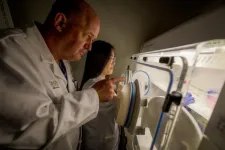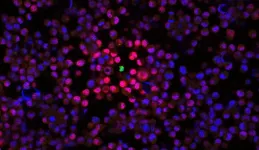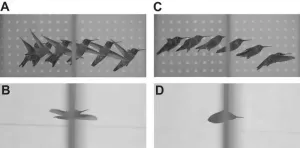(Press-News.org) Gut bacteria protects against diarrhoeal disease
Peer reviewed - Systematic review – people and animals
The severity of a diarrhoeal disease could be down to the bacteria in your gut – according to new research from the University of East Anglia.
Cryptosporidiosis is responsible for over 100,000 deaths annually – predominantly in children under five.
It also affects animals, and a new study published today shows that large animals – including primates - with less different kinds of bacteria in their gut are the more severely affected.
It reveals that introducing more diverse gut bacteria can improve outcomes – including reducing diarrhoea and potential for the disease to spread.
The team, led by Prof Kevin Tyler at UEA’s Norwich Medical School, say that diet, probiotics and faecal transplant therapy could help target the disease by improving gut bacteria in people and animals.
Prof Tyler said: “The vast majority of infections and deaths happen in low-income countries, but outbreaks also occur in the UK and elsewhere in Europe.
“In the UK, the disease is currently re-emerging and cases this year are increasing dramatically, suggesting the disease is currently epidemic. There are no human vaccines and only one drug licensed for human use, which is not effective for many who are affected.
“So, understanding what that can improve outcomes is critical to tackling outbreaks.
“We wanted to know whether some of the variation in symptoms might relate to the make-up of an infected person or animal’s gut bacteria and whether that composition was in turn affected by having cryptosporidiosis.”
The team collected all studies that had looked at the composition of gut bacteria in mammals which were infected by cryptosporidium and for which the data had been made publicly available.
They compared these to answer questions about the significance of gut bacterial diversity and the effect of cryptosporidium infection.
Lead researcher Georgina Hurle, also from UEA’s Norwich Medical School, said: “The Cryptosporidium parasite is one of several microorganisms that cause diarrhoeal disease. It affects both babies and new-born livestock and it can be contracted either from animals or from people.
“Most people contracting cryptosporidiosis will recover naturally, but some people and animals will require treatment, suffer long term consequences from the infection, and may even die.
“The severity of the disease is known to be affected by prior exposure, so adults are generally less severely infected and recover better.
“We found that more severely affected large animals such as cows, sheep and primates, have less different kinds of bacteria in their gut.
“We also found that having and even introducing more diverse gut bacteria can improve outcomes, reducing diarrhoea and potential for disease transmission.
“Gut bacteria composition can be affected by diet, by consumption of probiotics and pre-biotics and by therapies like faecal transplant therapy.
“Understanding the changes that accompany infections and outcomes provides an opportunity for such relatively affordable but novel therapies in targeting a disease for which very few interventions are currently available.
“This study is important in showing that these approaches may be effective at reducing disease severity in those affected and at-risk groups and populations.”
‘Microbiome diversity is a modifiable virulence factor for Cryptosporidiosis’ is published in the journal Virulence.
ENDS
END
Gut bacteria protects against diarrhoeal disease
2023-11-10
ELSE PRESS RELEASES FROM THIS DATE:
Found at last: Bizarre, egg-laying mammal finally rediscovered after 60 years
2023-11-10
A long-beaked echidna named after Sir David Attenborough and last seen by scientists in 1961 has been photographed for the first time in an Indonesian tropical forest.
An international team of researchers worked with local communities to deploy over 80 camera traps to film the elusive animal.
Besides rediscovering the echidna, the team uncovered a wealth of species completely new to science, including beetles, spiders, and a remarkable tree-dwelling shrimp.
A wide range of images and video footage from the expedition are available (see link below).
More than sixty years after it was last recorded, an expedition ...
WHO updates its guidance on treatments for COVID-19
2023-11-10
A panel of international experts representing the World Health Organization’s Guideline Development Group has updated its guidance on treatments for patients with covid-19.
The new recommendations published by The BMJ are part of a living guideline, developed by the World Health Organization with the methodological support of MAGIC Evidence Ecosystem Foundation, to provide up to date, trustworthy guidance on the management of covid-19 and help doctors make better decisions with their patients.
The guidance ...
UTHealth Houston researchers awarded $2.6 million NIH grant to study molecular pathways and potential strategies for treatment of myocardial ischemia and reperfusion injury
2023-11-10
A four-year, $2.6 million grant to study circadian rhythm and novel therapies to protect the heart during a heart attack or cardiac surgery has been awarded to UTHealth Houston by the National Heart, Lung, and Blood Institute, part of the National Institutes of Health.
Principal investigator Holger Eltzschig, MD, PhD, professor, and co-investigator Wei Ruan, MD, PhD, assistant professor, from the Department of Anesthesiology, Critical Care and Pain Medicine at McGovern Medical School at UTHealth Houston, are studying translational, pharmacologic, and interventional strategies targeting ...
What human diseases can teach us about the immune system
2023-11-10
The immune system is a crucial part of our survival, regularly fending off wide-ranging attacks on the body, both internal and external. Unsurprisingly, the elegant defense system that protects us from viruses, bacterial infections, cancer, and other threats is immensely complicated. Each time it mounts a response, it must quickly and carefully orchestrate communication across vast numbers of cells and molecules.
Jennifer Oyler-Yaniv is working to figure out how, exactly, the immune system does this — and when and why it fails.
“There's always the next question, the next ...
Texas A&M researchers contribute to international project studying coronavirus transmission in humans, cattle
2023-11-10
Researchers from the Texas A&M School of Veterinary Medicine and Biomedical Sciences’ (VMBS) Veterinary Education, Research, and Outreach (VERO) program have joined an international team studying how coronaviruses are spread and whether an individual’s microbiome (the collection of microbes living in or on the body) might impact that transmission.
Coronaviruses are a family of viruses that can cause a variety of diseases in many species, from the common cold and severe acute respiratory syndrome (SARS) in people, to diarrhea in calves and respiratory disease in ...
NASA’s Webb, Hubble telescopes combine to create most colorful view of universe
2023-11-10
Astronomers once again have combined the observational powers of NASA’s James Webb Space Telescope and Hubble Space Telescope to create one of the most detailed and colorful portraits of the cosmos, just in time for the holiday season.
The new image, dubbed the Christmas Tree Galaxy Cluster by the research team that includes Texas A&M University astronomer Dr. Lifan Wang, combines visible light from Hubble with infrared light detected by Webb to showcase MACS0416, a galaxy cluster about 4.3 billion light-years from Earth. Because the cluster is able to magnify the light from more distant background galaxies through a phenomenon known as gravitational ...
Ten 2023 postdoctoral fellowships in aging research awarded by the Glenn Foundation for Medical Research and AFAR
2023-11-10
NEW YORK, NY and SANTA BARBARA, CA — The American Federation for Aging Research (AFAR) and the Glenn Foundation for Medical Research are pleased to announce the recipients of the 2023 Glenn Foundation for Medical Research Postdoctoral Fellowships in Aging Research. This program supports postdoctoral fellowswho study basic research mechanisms of aging and/or translational findings that have potential to directly benefit human health.
Selected through a rigorous review process, ten, one-year, $75,000 Postdoctoral ...
Mystery solved: how hummingbirds fly through gaps that are too small
2023-11-10
Soaring, wings outstretched, many birds sail through the air unhindered. However, species that dine on fruit, seeds and nectar must negotiate tiny gaps in cluttered foliage to secure a feast. To pass through apertures, many birds pull in their wings, folding them closer to their bodies. However, some of the most manoeuvrable aviators, hummingbirds, have lost the ability to fold their wings at the wrists and elbows. ‘Unless hummingbirds implement distinctive strategies to transit narrow apertures, they may be unable to enter gaps less than one wingspan wide’, ...
Hummingbirds' unique sideways flutter gets them through small apertures
2023-11-10
Most birds that flit through dense, leafy forests have a strategy for maneuvering through tight windows in the vegetation — they bend their wings at the wrist or elbow and barrel through.
But hummingbirds can't bend their wing bones during flight, so how do they transit the gaps between leaves and tangled branches?
A study published today in the Journal of Experimental Biology shows that hummingbirds have evolved their own unique strategies — two of them, in fact. These strategies have not been reported before, likely because hummers maneuver too ...
National analysis suggests that potentially serious complications occur in 1 in 18 procedures under the care of an anaesthetist
2023-11-10
New survey data from the 7th National Audit Project of the Royal College of Anaesthetists (NAP7) published in Anaesthesia (the journal of the Association of Anaesthetists) shows that potentially serious complications occur in one in 18 procedures under the care of an anaesthetist.
The risk factors associated with these potentially serious complications include very young age (babies); comorbidities; being male; increased frailty; the urgency and extent of surgery; and surgery taking place at night and/or at weekends.
This paper has been produced by a team of authors across ...





